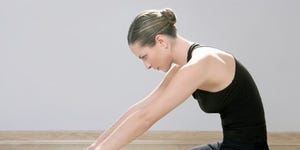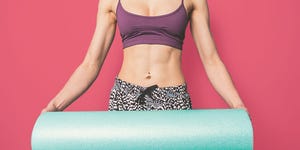When you only have a limited amount of time to work out, foam rolling probably loses out to Bravo-fueled elliptical sessions. But here’s why that’s a bad idea: Beyond the fact that foam rolling is basically like giving yourself a massage (yes, please!) it’s also an amazing tool for post-fitness recovery.
There’s a reason you have that friend who swears by her-post run foam roll!
Why foam rollers are great
Foam rollers can benefit literally every type of exerciser—according to research published in The Journal of Athletic Training, foam rolling after a workout significantly decreases soreness up to 72 hours later.

That’s because foam rolling is a type of myofascial massage, or a kind of therapy that keeps your muscles loose and well-hydrated and eases pain in the tissues that wrap around, connect, and support your muscles. When those babies are stiff, they can actually restrict movement and lead to muscle pain all over.
“Ideally, you should get a massage every couple of days to keep your muscles healthy, particularly if you’re a runner,” says Raechel Bugner, D.P.T., a doctor of physical therapy from Finish Line Physical Therapy in New York City. “No one has time for money for that, but foam rolling takes its place.”
How to use a foam roller
Most foam rollers are made of a type of foam called EVA, and come in varying densities—hard, medium, and soft—depending on how much pressure you want when you roll. Rolling your muscles on that surface can help break up knots, which constrict the blood flow and keep your muscles from functioning properly, Bugner explains. Rollers can also release tension, soothe sore muscles, and increase your mobility—generally helping to boost your performance.

To get the most out of foam rolling, though, you want to “roll as slowly as you can,” says Bugner. That’ll give your muscles time to loosen.
But foam rolling isn’t for everyone, and if the pressure is too much or it hurt-hurts rather than hurts-so-good, try a different roller or skip it completely for a different kind of stretching. Foam rolling should make you feel better, not worse.
Finding the right foam roller
Not all foam rollers are created equally. Depending on the type of exercise you do, the kind of pressure you want, and the aches and pains you’re experience, you’ll want to use a roller tailored to your needs. These are some of the best on the market to choose from. Roll on!
Source: Read Full Article
